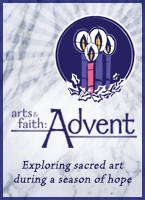Arts & Faith: Week 2 of Advent, Cycle C
Mattia Preti, “St. John the Baptist Preaching,” circa 1665

Mattia Preti’s St. John the Baptist Preaching shows John in the wilderness, sharing his message with a small crowd of captivated followers. He is surrounded by symbols that invite us into his story. The red garment that envelops half of his body brings to mind the martyrdom he will endure. The staff and banner are signs of his prophetic role heralding the coming of Christ, and the lamb at the bottom center of the scene echoes John’s announcement of Christ as the Lamb of God.
The broken tree stump that St. John leans on is also telling us a story. Its trunk is almost wide and solid enough to be an altar. This seen together with the red cloth and the lamb subtly evokes sacrifice: the story of Abraham and Isaac perhaps, but more clearly the cross itself, the ultimate tree of sacrifice. The trunk is dead and broken, its branches split and severed, but John’s body leaning on it gives it life. It is as if John’s torso and extended arm become the living extension of the tree, giving a seemingly exhausted trunk new life and purpose. In this, the image invites us to reflect on the power of the life-giving Word of God, which St. John is heralding.
Another interesting detail is the angel in the top right of the scene, directly engaging the viewer with his gaze. The angel’s direct gaze makes him the storyteller. This is by no accident, as in Scripture, angels are messengers of God. Luke’s Gospel for the Second Sunday of Advent tells us that the Word of God came to John in the desert, and Preti gives us an angel, a herald of the Word of God, to show this and the divine source animating St. John’s work. But as the angel looks at us square on, his presence is also a call to the viewer to both accept the Word and to share it. This Second Sunday of Advent, we do not simply hear about the prophet John; in hearing the Word ourselves, we are called to live prophetically and to prepare the way all around us.

Commentary is by Daniella Zsupan-Jerome, director of ministerial formation at Saint John's University School of Theology and Seminary.
Related Ignatian reflection on this week’s art
Week 2 of Advent, Cycle C

Prepare the Way (Ages 9–12)
Invite young people to brainstorm how John the Baptist might communicate his message if he lived today. (social media, television, books, etc.) Encourage young people to think about how people today are still preparing the way for the Lord through modern communication methods as well as through speeches and conversations (methods which were available to the prophet John). Lead a discussion about how today’s Christians spread the Word of God.
What's Your Message (Ages 12–15)
View Preti’s St. John the Baptist Preaching and help young people to notice John’s gaze directed at the viewer. Ask: What do you imagine John the Baptist is saying? Distribute writing materials and direct the young people to write what message they would share about the coming of the Lord. Invite volunteers to share their responses.

